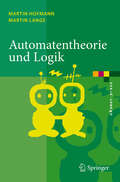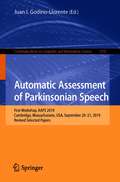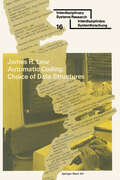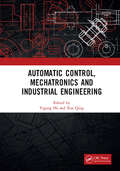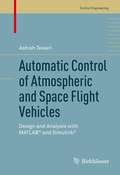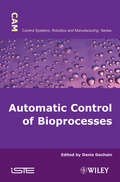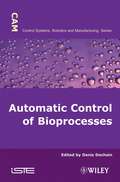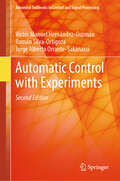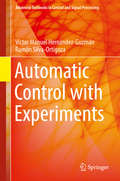- Table View
- List View
Automaten: Die konstruktive Durchbildung die Werkzeuge, die Arbeitsweise und der Betrieb der selbsttätigen Drehbänke. Ein Lehr- und Nachschlagebuch
by Philipp KelleDieser Buchtitel ist Teil des Digitalisierungsprojekts Springer Book Archives mit Publikationen, die seit den Anfängen des Verlags von 1842 erschienen sind. Der Verlag stellt mit diesem Archiv Quellen für die historische wie auch die disziplingeschichtliche Forschung zur Verfügung, die jeweils im historischen Kontext betrachtet werden müssen. Dieser Titel erschien in der Zeit vor 1945 und wird daher in seiner zeittypischen politisch-ideologischen Ausrichtung vom Verlag nicht beworben.
Automaten Sprachen Berechenbarkeit: Grundkurs Angewandte Informatik IV (XLeitfäden der Informatik)
by Wolffried Stucky Rudolf HerschelAutomatentheorie: Eine Einführung in die Theorie endlicher Automaten (Leitfäden und Monographien der Informatik)
by Wilfried BrauerAutomatentheorie und Logik (eXamen.press)
by Martin Hofmann Martin LangeDas Buch beschäftigt sich mit der Theorie endlicher Automaten und den klassischen Resultaten wie den Sätzen von Richard Büchi und Michael Rabin. Die vier Teile des Buchs sind den unterschiedlichen Strukturen gewidmet: endliche Wörter, Bäume, endliche und unendliche Bäume. Jeder Teil endet mit Übungsaufgaben zum behandelten Stoff sowie Hinweisen auf weiterführende Literatur. Soweit Vorkenntnisse zur Theorie formaler Sprachen vorhanden sind, kann das Buch ohne weitere Hilfsmittel durchgearbeitet werden.
Automatic Algorithm Selection for Complex Simulation Problems
by Roland EwaldTo select the most suitable simulation algorithm for a given task is often difficult. This is due to intricate interactions between model features, implementation details, and runtime environment, which may strongly affect the overall performance. An automated selection of simulation algorithms supports users in setting up simulation experiments without demanding expert knowledge on simulation. Roland Ewald analyzes and discusses existing approaches to solve the algorithm selection problem in the context of simulation. He introduces a framework for automatic simulation algorithm selection and describes its integration into the open-source modelling and simulation framework James II. Its selection mechanisms are able to cope with three situations: no prior knowledge is available, the impact of problem features on simulator performance is unknown, and a relationship between problem features and algorithm performance can be established empirically. The author concludes with an experimental evaluation of the developed methods.
Automatic Analog IC Sizing and Optimization Constrained with PVT Corners and Layout Effects
by Nuno Lourenço Ricardo Martins Nuno HortaThis book introduces readers to a variety of tools for automatic analog integrated circuit (IC) sizing and optimization. The authors provide a historical perspective on the early methods proposed to tackle automatic analog circuit sizing, with emphasis on the methodologies to size and optimize the circuit, and on the methodologies to estimate the circuit’s performance. The discussion also includes robust circuit design and optimization and the most recent advances in layout-aware analog sizing approaches. The authors describe a methodology for an automatic flow for analog IC design, including details of the inputs and interfaces, multi-objective optimization techniques, and the enhancements made in the base implementation by using machine leaning techniques. The Gradient model is discussed in detail, along with the methods to include layout effects in the circuit sizing. The concepts and algorithms of all the modules are thoroughly described, enabling readers to reproduce the methodologies, improve the quality of their designs, or use them as starting point for a new tool. An extensive set of application examples is included to demonstrate the capabilities and features of the methodologies described.
Automatic Architecture: Motivating Form after Modernism
by Sean KellerIn the 1960s and ’70s, architects, influenced by recent developments in computing and the rise of structuralist and poststructuralist thinking, began to radically rethink how architecture could be created. Though various new approaches gained favor, they had one thing in common: they advocated moving away from the traditional reliance on an individual architect’s knowledge and instincts and toward the use of external tools and processes that were considered objective, logical, or natural. Automatic architecture was born. The quixotic attempts to formulate such design processes extended modernist principles and tried to draw architecture closer to mathematics and the sciences. By focusing on design methods, and by examining evidence at a range of scales—from institutions to individual buildings—Automatic Architecture offers an alternative to narratives of this period that have presented postmodernism as a question of style, as the methods and techniques traced here have been more deeply consequential than the many stylistic shifts of the past half century. Sean Keller closes the book with an analysis of the contemporary condition, suggesting future paths for architectural practice that work through, but also beyond, the merely automatic.
Automatic Architecture: Motivating Form after Modernism
by Sean KellerIn the 1960s and ’70s, architects, influenced by recent developments in computing and the rise of structuralist and poststructuralist thinking, began to radically rethink how architecture could be created. Though various new approaches gained favor, they had one thing in common: they advocated moving away from the traditional reliance on an individual architect’s knowledge and instincts and toward the use of external tools and processes that were considered objective, logical, or natural. Automatic architecture was born. The quixotic attempts to formulate such design processes extended modernist principles and tried to draw architecture closer to mathematics and the sciences. By focusing on design methods, and by examining evidence at a range of scales—from institutions to individual buildings—Automatic Architecture offers an alternative to narratives of this period that have presented postmodernism as a question of style, as the methods and techniques traced here have been more deeply consequential than the many stylistic shifts of the past half century. Sean Keller closes the book with an analysis of the contemporary condition, suggesting future paths for architectural practice that work through, but also beyond, the merely automatic.
Automatic Architecture: Motivating Form after Modernism
by Sean KellerIn the 1960s and ’70s, architects, influenced by recent developments in computing and the rise of structuralist and poststructuralist thinking, began to radically rethink how architecture could be created. Though various new approaches gained favor, they had one thing in common: they advocated moving away from the traditional reliance on an individual architect’s knowledge and instincts and toward the use of external tools and processes that were considered objective, logical, or natural. Automatic architecture was born. The quixotic attempts to formulate such design processes extended modernist principles and tried to draw architecture closer to mathematics and the sciences. By focusing on design methods, and by examining evidence at a range of scales—from institutions to individual buildings—Automatic Architecture offers an alternative to narratives of this period that have presented postmodernism as a question of style, as the methods and techniques traced here have been more deeply consequential than the many stylistic shifts of the past half century. Sean Keller closes the book with an analysis of the contemporary condition, suggesting future paths for architectural practice that work through, but also beyond, the merely automatic.
Automatic Architecture: Motivating Form after Modernism
by Sean KellerIn the 1960s and ’70s, architects, influenced by recent developments in computing and the rise of structuralist and poststructuralist thinking, began to radically rethink how architecture could be created. Though various new approaches gained favor, they had one thing in common: they advocated moving away from the traditional reliance on an individual architect’s knowledge and instincts and toward the use of external tools and processes that were considered objective, logical, or natural. Automatic architecture was born. The quixotic attempts to formulate such design processes extended modernist principles and tried to draw architecture closer to mathematics and the sciences. By focusing on design methods, and by examining evidence at a range of scales—from institutions to individual buildings—Automatic Architecture offers an alternative to narratives of this period that have presented postmodernism as a question of style, as the methods and techniques traced here have been more deeply consequential than the many stylistic shifts of the past half century. Sean Keller closes the book with an analysis of the contemporary condition, suggesting future paths for architectural practice that work through, but also beyond, the merely automatic.
Automatic Assessment of Parkinsonian Speech: First Workshop, AAPS 2019, Cambridge, Massachussets, USA, September 20–21, 2019, Revised Selected Papers (Communications in Computer and Information Science #1295)
by Juan I. Godino-LlorenteThis book constitutes the revised and extended papers of the First Automatic Assessment of Parkinsonian Speech Workshop, AAPS 2019, held in Cambridge, Massachusetts, USA, in September 2019. The 6 full papers were thoroughly reviewed and selected from 15 submissions. They present recent research on the automatic assessment of parkinsonian speech from the point of view of such disciplines as machine learning, speech technology, phonetics, neurology, and speech therapy
Automatic Autocorrelation and Spectral Analysis
by Petrus M.T. BroersenSpectral analysis requires subjective decisions which influence the final estimate and mean that different analysts can obtain different results from the same stationary stochastic observations. Statistical signal processing can overcome this difficulty, producing a unique solution for any set of observations but that is only acceptable if it is close to the best attainable accuracy for most types of stationary data. This book describes a method which fulfils the above near-optimal-solution criterion, taking advantage of greater computing power and robust algorithms to produce enough candidate models to be sure of providing a suitable candidate for given data.
Automatic Calibration and Reconstruction for Active Vision Systems (Intelligent Systems, Control and Automation: Science and Engineering #57)
by Beiwei Zhang Y. F. LiIn this book, the design of two new planar patterns for camera calibration of intrinsic parameters is addressed and a line-based method for distortion correction is suggested. The dynamic calibration of structured light systems, which consist of a camera and a projector is also treated. Also, the 3D Euclidean reconstruction by using the image-to-world transformation is investigated. Lastly, linear calibration algorithms for the catadioptric camera are considered, and the homographic matrix and fundamental matrix are extensively studied. In these methods, analytic solutions are provided for the computational efficiency and redundancy in the data can be easily incorporated to improve reliability of the estimations. This volume will therefore prove valuable and practical tool for researchers and practioners working in image processing and computer vision and related subjects.
Automatic Coding: Choice of Data Structures (Interdisciplinary Systems Research)
by LOW1.0 2 information structures, and the runtime efficiency available using lower level data structures. We believe these runtime inefficiencies can be remedied by providing a library of representations for the information structures and a user assisted automatic system to choose appropriate elements from this library for the user's programs. The main problems in such an automatic approach are: 1). Building a library of representations; 2). Characterizing the properties of these representations; 3). understanding how the user's program actually uses the abstract information structures; and -4). efficiently matching the user program needs with the properties of the known representations. The research reported here is an attempt to demonstrate the feasibility of such automatic representation selection. We allow the user to express data in terms of relations, sets, and sequences. Our system then obtains information by analysis of the program, execution statement profiles and interrogation of the user. Using that information, the system selects efficient (in terms of time and space) low level implementations for the user's information structures from a fixed library of information structure representations. Though we have considered only a few abstract information structures (those available in our programming language, SAIL) we believe the techniques used in this system are generally applicable.
Automatic Control and Emerging Technologies: Proceedings of ACET 2023 (Lecture Notes in Electrical Engineering #1141)
by Hassan El Fadil Weicun ZhangThis book contains the original, peer-reviewed research papers from the International Symposium on Automatic Control and Emerging Technologies, held in Kenitra, Morrocco, on July 11-13, 2023. The topics covered include but are not limited to: System Identification, Linear/Nonlinear Control Systems, Data-driven Modelling and Control, Process Modelling and Process Control, Fault Diagnosis and Reliable Control, Intelligent Systems, and Machine Learning and Artificial Intelligence.The papers showcased here share the latest findings on topics with potential for academic research and industrial applications, making the book a valuable resource for researchers, engineers, and university students alike.
Automatic Control, Mechatronics and Industrial Engineering: Proceedings of the International Conference on Automatic Control, Mechatronics and Industrial Engineering (ACMIE 2018), October 29-31, 2018, Suzhou, China
Engineering technology development and implementation play an important role in making the industry more sustainable in an increasingly competitive world. This book covers significant recent developments in both fundamental and applied research in the engineering field. Domains of application include, but are not limited to, Intelligent Control Systems and Optimization, Signal Processing, Sensors, Systems Modeling and Control, Robotics and Automation, Industrial and Electric Engineering, Production and Management. This book is an excellent reference work to get up to date with the latest research and developments in the fields of Automation, Mechatronics and Industrial Engineering. It aims to provide a platform for researchers and professionals in all relevant fields to gain new ideas and establish great achievements in scientific development.
Automatic Control of Atmospheric and Space Flight Vehicles: Design and Analysis with MATLAB® and Simulink® (Control Engineering)
by Ashish TewariAutomatic Control of Atmospheric and Space Flight Vehicles is perhaps the first book on the market to present a unified and straightforward study of the design and analysis of automatic control systems for both atmospheric and space flight vehicles. Covering basic control theory and design concepts, it is meant as a textbook for senior undergraduate and graduate students in modern courses on flight control systems. In addition to the basics of flight control, this book covers a number of upper-level topics and will therefore be of interest not only to advanced students, but also to researchers and practitioners in aeronautical engineering, applied mathematics, and systems/control theory.
Automatic Control of Bioprocesses
by Denis DochainGiving an overview of the challenges in the control of bioprocesses, this comprehensive book presents key results in various fields, including: dynamic modeling; dynamic properties of bioprocess models; software sensors designed for the on-line estimation of parameters and state variables; control and supervision of bioprocesses.
Automatic Control of Bioprocesses
by Denis DochainGiving an overview of the challenges in the control of bioprocesses, this comprehensive book presents key results in various fields, including: dynamic modeling; dynamic properties of bioprocess models; software sensors designed for the on-line estimation of parameters and state variables; control and supervision of bioprocesses.
Automatic Control of Food Manufacturing Processes
by I. McFarlaneIn the ten years since the first edition of this book appeared there have been significant developments in food process engineering, notably in biotechnology and membrane application. Advances have been made in the use of sensors for process control, and the growth of information technology and on-line computer applications continues apace. In addition, plant investment decisions are increasingly determined by quality assurance considerations and have to incorporate a greater emphasis on health and safety issues. The content of this edition has been rearranged to include descriptions of recent developments and to reflect the influence of new technology on the control and operations of automated plant. Original examples have been retained where relevant and these, together with many new illustrations, provide a comprehensive guide to good practice.
Automatic Control, Robotics, and Information Processing (Studies in Systems, Decision and Control #296)
by Piotr Kulczycki Józef Korbicz Janusz KacprzykThis book presents a wide and comprehensive range of issues and problems in various fields of science and engineering, from both theoretical and applied perspectives. The desire to develop more effective and efficient tools and techniques for dealing with complex processes and systems has been a natural inspiration for the emergence of numerous fields of science and technology, in particular control and automation and, more recently, robotics. The contributions gathered here concern the development of methods and algorithms to determine best practices regarding broadly perceived decisions or controls. From an engineering standpoint, many of them focus on how to automate a specific process or complex system. From a tools-based perspective, several contributions address the development of analytic and algorithmic methods and techniques, devices and systems that make it possible to develop and subsequently implement the automation and robotization of crucial areas of human activity. All topics discussed are illustrated with sample applications.
Automatic Control Systems: With MATLAB
by S. PalaniThis book is designed to serve as a textbook for courses offered to undergraduate students enrolled in Electrical Engineering and related disciplines. The book provides a comprehensive coverage of linear system theory. In this book, the concepts around each topic are well discussed with a full-length presentation of numerical examples. Each example is unique in its way, and it is graded sequentially. This book highlights simple methods for solving problems. Even though, the subject requires a very strong mathematical foundation, wherever possible, rigorous mathematics is simplified for a quick understanding of the basic concepts. The book also includes select numerical problems to test the capability of the students. Time and frequency domain approaches for the analysis and design of linear automatic control systems have been explained using state-space and transfer function models of physical systems. All the chapters include a short theoretical summary of the topic followed by exercises on solving complex problems using MATLAB commands. In addition, each chapter offers a large number of end-of-chapter homework problems. This second edition includes a new chapter on state-space modeling and analysis. Detailed conceptual coverage and pedagogical tools make this an ideal textbook for students and researchers enrolled in electrical engineering and related programs.
Automatic Control Systems in Biomedical Engineering: An Interactive Educational Approach
by J. Fernández de Cañete C. Galindo J. Barbancho A. LuqueThis book presents the fundamental principles and challenges encountered in the control of biomedical systems, providing practical solutions and suggesting alternatives. The perspective of the text is based on the system behaviour in the time domain both linear and non-linear, continuous and discrete, helping the reader to be able to interpret the physical significance of mathematical results during control system analysis and design focusing on biomedical engineering applications. Interactive learning is promoted, endowing students with the ability to change parameters and conditions during the simulation and see the effects of these changes, by using interactive MATLAB and SIMULINK software tools, also presenting realistic problems in order to analyse, design and develop automatic control systems. The text is also complemented with MATLAB and SIMULINK exercise files solved to aid students to focus on the fundamental concepts treated throughout the book, following a new pedagogical approach distinct from the classical one whereby fundamental control concepts are introduced together with adequate software tools in order to gain insight on the biomedical engineering control problems. The book is suitable for second or third-year undergraduate students who will find the illustrative examples particularly useful to their studies of control system design and implementation. Lecturers in the control field will find the computer aided design approach as an alternative to teaching the fundamental concepts of feedback analogic and digital control.
Automatic Control with Experiments (Advanced Textbooks in Control and Signal Processing)
by Victor Manuel Hernández-Guzmán Ramón Silva-Ortigoza Jorge Alberto Orrante-SakanassiThis book offers an enhanced and comprehensive understanding of control theory and its practical applications. The theoretical chapters on control tools have been meticulously revised and improved to provide a clearer and more insightful exploration of the fundamental concepts and ideas. The explanations have been refined, and new examples have been added to aid comprehension. Additionally, a new chapter on discrete-time systems has been included, delving into an important aspect of control theory. Advanced topics in control are also covered in greater detail, ensuring a comprehensive treatment of the subject matter. The section on experimental applications has been revamped to showcase the application of control ideas in various scenarios. Several chapters have been replaced with fresh content that focuses on controlling new and different experimental prototypes. These examples illustrate how control concepts can be effectively applied in real-world situations. Furthermore,this book introduces a new approach for control of non-minimum phase systems and explores the concept of differential flatness for multiple-input multiple-output systems. Additionally, a fascinating application involving a wheeled pendulum mobile robot has been included. While some chapters have been replaced, the second edition retains the chapters on the control of DC motors and the control of a magnetic levitation system. However, the material in the former chapter is mostly new, and the latter chapter is entirely supported by new control concepts and ideas.
Automatic Control with Experiments (Advanced Textbooks in Control and Signal Processing)
by Victor Manuel Hernández-Guzmán Ramón Silva-OrtigozaThis textbook presents theory and practice in the context of automatic control education. It presents the relevant theory in the first eight chapters,applying them later on to the control of several real plants. Each plant is studied following a uniform procedure: a) the plant’s functionis described, b) a mathematical model is obtained, c) plant construction is explained in such a way that the reader can build his or her own plant to conduct experiments, d) experiments are conducted to determine the plant’s parameters, e) a controller is designed using the theory discussed in the first eight chapters, f) practical controller implementation is performed in such a way that the reader can build the controller in practice, and g) the experimental results are presented. Moreover, the book provides a wealth of exercises and appendices reviewing the foundations of several concepts and techniques in automatic control. The control system construction proposed is based on inexpensive, easy-to-use hardware. An explicit procedure for obtaining formulas for the oscillation condition and the oscillation frequency of electronic oscillator circuits is demonstrated as well.



